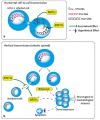Antiretroviral Therapy in HTLV-1 Infection: An Updated Overview
- PMID: 32369988
- PMCID: PMC7281255
- DOI: 10.3390/pathogens9050342
Antiretroviral Therapy in HTLV-1 Infection: An Updated Overview
Abstract
The human T cell leukemic/lymphotropic virus type 1 (HTLV-1), discovered several years ago, is the causative agent for a rapid progressive haematological malignancy, adult T cell leukemia (ATL), for debilitating neurological diseases and for a number of inflammatory based diseases. Although the heterogeneous features of the diseases caused by HTLV-1, a common topic concerning related therapeutic treatments relies on the use of antiretrovirals. This review will compare the different approaches and opinions in this matter, giving a concise overview of preclinical as well as clinical studies covering all the aspects of antiretrovirals in HTLV-1 infection. Studies will be grouped on the basis of the class of antiretroviral, putting together both pre-clinical and clinical results and generally following a chronological order. Analysis of the existing literature highlights that a number of preclinical studies clearly demonstrate that different classes of antiretrovirals, already utilized as anti-HIV agents, are actually capable to efficiently contrast HTLV-1 infection. Nevertheless, the results of most of the clinical studies are generally discouraging on the same point. In conclusion, the design of new antiretrovirals more specifically focused on HTLV-1 targets, and/or the establishment of early treatments with antiretrovirals could hopefully change the perspectives of diseases caused by HTLV-1.
Keywords: ATL; HAM/TSP; HTLV-1; antiretrovirals.
Conflict of interest statement
The authors declare no conflict of interest.
Figures

Similar articles
-
Establishment of a Cynomolgus Macaque Model of Human T-Cell Leukemia Virus Type 1 (HTLV-1) Infection by Direct Inoculation of Adult T-Cell Leukemia Patient-Derived Cell Lines for HTLV-1 Infection.J Virol. 2022 Nov 23;96(22):e0133922. doi: 10.1128/jvi.01339-22. Epub 2022 Oct 31. J Virol. 2022. PMID: 36314828 Free PMC article.
-
T cell receptor repertoire analysis in HTLV-1-associated diseases.Front Immunol. 2022 Sep 15;13:984274. doi: 10.3389/fimmu.2022.984274. eCollection 2022. Front Immunol. 2022. PMID: 36189294 Free PMC article. Review.
-
Adult T cell leukemia following HTLV-I-associated myelopathy/tropical spastic paraparesis: case reports and implication to the natural course of ATL.Leukemia. 1995 Oct;9(10):1768-70. Leukemia. 1995. PMID: 7564523
-
Manifestations of the human T-cell lymphotropic virus type I infection in childhood and adolescence.J Pediatr (Rio J). 2006 Nov-Dec;82(6):411-20. doi: 10.2223/JPED.1573. J Pediatr (Rio J). 2006. PMID: 17171202 Review.
-
Presence of tropical spastic paraparesis/human T-cell lymphotropic virus type 1-associated myelopathy (TSP/HAM)-like among HIV-1-infected patients.J Med Virol. 2008 Mar;80(3):392-8. doi: 10.1002/jmv.21111. J Med Virol. 2008. PMID: 18205234
Cited by
-
Co-Infection and Cancer: Host-Pathogen Interaction between Dendritic Cells and HIV-1, HTLV-1, and Other Oncogenic Viruses.Viruses. 2022 Sep 14;14(9):2037. doi: 10.3390/v14092037. Viruses. 2022. PMID: 36146843 Free PMC article. Review.
-
Overview on coinfection of HTLV-1 and tuberculosis: Mini-review.J Clin Tuberc Other Mycobact Dis. 2021 Feb 19;23:100224. doi: 10.1016/j.jctube.2021.100224. eCollection 2021 May. J Clin Tuberc Other Mycobact Dis. 2021. PMID: 33681477 Free PMC article. Review.
-
HTLV-1 reverse transcriptase homology model provides structural basis for sensitivity to existing nucleoside/nucleotide reverse transcriptase inhibitors.Virol J. 2024 Jan 10;21(1):14. doi: 10.1186/s12985-024-02288-z. Virol J. 2024. PMID: 38200531 Free PMC article.
-
Development of a Novel HTLV-1 Protease: Human Fcγ1 Recombinant Fusion Molecule in the CHO Eukaryotic Expression System.Appl Biochem Biotechnol. 2023 Mar;195(3):1862-1876. doi: 10.1007/s12010-022-04259-y. Epub 2022 Nov 18. Appl Biochem Biotechnol. 2023. PMID: 36399306 Free PMC article.
-
HTLV-1 Infection and Pathogenesis: New Insights from Cellular and Animal Models.Int J Mol Sci. 2021 Jul 27;22(15):8001. doi: 10.3390/ijms22158001. Int J Mol Sci. 2021. PMID: 34360767 Free PMC article. Review.
References
-
- Poiesz B.J., Ruscetti F.W., Gazdar A.F., Bunn P.A., Minna J.D., Gallo R.C. Detection and isolation of type C retrovirus particles from fresh and cultured lymphocytes of a patient with cutaneous T-cell lymphoma. Proc. Natl. Acad. Sci. USA. 1980;77:7415–7419. doi: 10.1073/pnas.77.12.7415. - DOI - PMC - PubMed
-
- Einsiedel L., Woodman R.J., Flynn M., Wilson K., Cassar O., Gessain A. Human T-Lymphotropic Virus type 1 infection in an Indigenous Australian population: Epidemiological insights from a hospital-based cohort study. BMC Public Health. 2016;16:787. doi: 10.1186/s12889-016-3366-5. - DOI - PMC - PubMed
Publication types
LinkOut - more resources
Full Text Sources
Miscellaneous

